Nike Air Zoom Pegasus 36 Trail
Test Locations: Gunnison – Crested Butte Valley, Colorado; Moab, Utah; San Gabriel Mountains, California
Test Duration: ~200 Miles
Stated Heel-to-Toe Drop: 10.0 mm
Stated Stack Height: 23.5 mm (heel) 13.5 mm (forefoot)
Stated Features:
- Perforated mesh and synthetic upper lets your foot breathe.
- Zoom Air units in heel and forefoot cushion your stride.
- Outsole lugs optimize traction on both roads and trails.
- Wider forefoot gives you a roomier fit.
- An overlay around the eyelets integrates with a traditional lacing system for secure lockdown.
- Cushlon foam cushions your foot and offers a supportive feel.
MSRP: $130.00
Reviewer: 5’9 , 115 lbs
Size Tested: US Women’s 7.5
Stated Weight per Shoe (US Women’s size 7): 235 grams / 8.3 oz
Blister’s Measured Weight per Shoe (US Women’s size 7.5): 234.5 grams / 8.27 oz
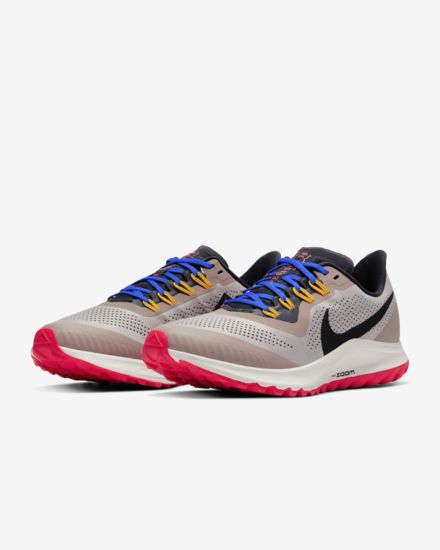
Intro
Nike is one of the best-known companies for road-running shoes, but is still a relatively new player in the world of trail-running shoes. Several years ago, the brand released their first trail shoes, the Wildhorse and the Terra Kiger. The Wildhorse was the first trail shoe I personally ran in.
The Pegasus 36 Trail is the newest addition to Nike’s lineup of trail running shoes. The shoe is based on the design of one of Nike’s most popular road shoes, the Pegasus. The Trail model takes the upper from the road model and pairs it with an outsole designed for trail running. I was eager to test out this shoe, as many people who I talked to about them had nothing but positive comments on the Pegasus 36 Trail.
I took this shoe across a wide variety of terrain, running on the rocky and packed-dirt trails around Crested Butte and Gunnison, Colorado, down to the sandy trails in Moab, Utah, and into the San Gabriel Mountains of California. I had heard from many that the Pegasus 36 trail was a great shoe for ultra-marathons, so I also put them to the test by wearing the shoes for a 50-mile event outside of Moab, Utah. Here is my take on the Pegasus 36 Trail’s general performance and how it compares to other options.
Fit
As with any shoe, we highly recommend trying on the Pegasus 36 Trail before buying, if possible. That said, I can talk about how the Pegasus 36 Trail fits my feet. For reference, I have large bunions and due to the shape of my pinky toes, I tend to get large blisters on my toes during long events. I look for shoes that give my toes enough room for long runs but still hug my otherwise-narrow feet. I tend to prefer shoes with heel-to-toe drops ranging from 5-9 mm.
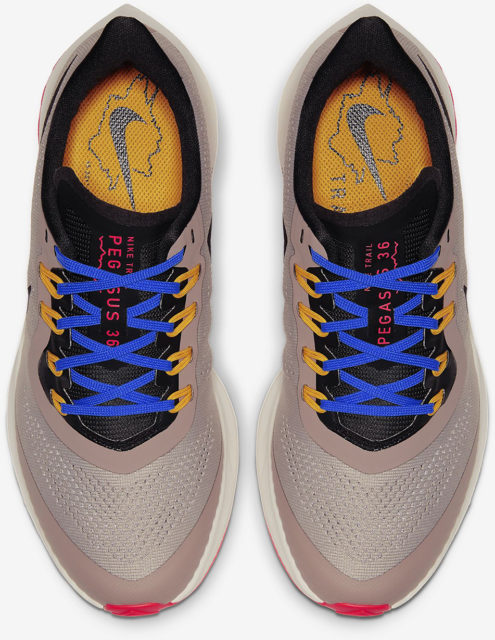
The Pegasus 36 Trail fits more snug and narrow than some of the other Nike shoes I’ve used, such as the Wildhorse and the Zoom Vomero 13. The fit of the Pegasus 36 Trail really reminded me of the road-running roots of the Pegasus. There was support throughout the arch where I feel a proper, snug fit is key. The stated features for the Pegasus claim it has a wider forefoot for a roomier fit, but I did not find this to be true — this is not a very high-volume shoe. The sides held my foot securely in place and the tongue laid flat against my foot without being too tight or bulky.
The heel cup of the Pegasus 36 Trail made me feel like my foot was sitting closer to the ground, even with its 10 mm drop and stated 23.5 mm stack height at the heel. I have struggled with some shoes with higher drops, making my feet feel like they were too high out of the shoe and creating an unstable feel — this shoe did not evoke that feeling. The cup held my heel in place and prevented any rubbing or blisters, regardless of if I was running fast on the sandy surface of the Moab Half Marathon or during a 50-mile effort.
The toe box of the Pegasus 36 Trail was the only area where the fit felt too snug for me. Initially, I felt like the toe box provided enough space for my toes to splay. But after a few runs in them, I started to experience a bit of pain in the middle of the toe pad of my foot. I worried it was an injury in the works, but when I put on other shoes, I felt no pain in this spot. I quickly pieced together that this pain was probably due to the shoe squeezing my forefoot a bit too much, causing pain on the toe pad. Since I have bunions, the extra width of my toes may have played a role in this. As I have put more miles on the shoe and the upper has stretched a bit, the pressure has been decreasing. But, because of this initial tightness, I would order a half-size larger next time.
Weight (and Comparisons)
The Pegasus 36 Trail is the lightest model in Nike’s trail lineup, and it’s a very lightweight shoe compared to the whole market. This lightweight design makes the shoe a good option for faster efforts like workouts and races on trails, but as I’ll get into later, I’ve enjoyed it outside of that niche. For reference, here are the stated weights of a few other shoes that are in a similar category as the Pegasus 36 Trail.
260 g (Men’s) / 225 g (Women’s) – La Sportiva Kaptiva
270 g (Men’s) / 235 g (Women’s) – Nike Air Zoom Pegasus Trail 36
280 g (Men’s) / 235 g (Women’s) – Salomon Sense Ride 3
Upper
The upper of the Pegasus 36 trail is made of a perforated mesh and synthetic, tightly woven fabric. The upper has areas around the top, midfoot, and heel that are reinforced with additional material to help prevent wear and add more support. I felt that the upper provided enough support to help my foot feel secure on varied terrain without feeling too hot. I also have had no issues with this shoe rubbing during the time I have spent testing it. I was very impressed by this, especially during sandy runs where I did get a decent amount of sand in my shoes.
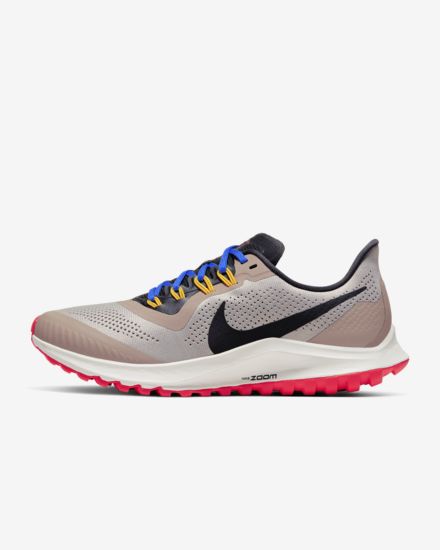
The tongue of the Pegasus 36 Trail is connected to the upper of the shoe at the second lace eyelet. I found this to be a huge perk as it prevented the tongue from sliding around or sitting weirdly on my feet. The tongue has a thinner construction than the rest of the upper, which provided enough padding for the top of my foot without feeling bulky. Since I like to tie my shoes pretty tight, I often have issues with laces rubbing against the top of my foot and creating hot spots. I found that the Pegasus 36 Trail did not do this, and even during a 50-mile run in them, there were no hot-spots on the top of my foot (or anywhere else for that matter) where rubbing had occurred.
Midsole & Cushioning
Nike’s website did not provide much context as to what to expect from the cushion and midsole of this shoe, other than stating that the “Cushlon foam cushions your foot and offers a supportive feel,” so I came in with no expectation of what the midsole and cushioning would feel like.
After my first run in the shoe, I felt like the Pegasus 36 Trail offered enough cushion for everyday training without being over the top and inefficient. I tend to like less-cushioned shoes, so the Pegasus 36 Trail was right up my alley. The cushion on the Pegasus 36 Trail felt firmer than I anticipated; the firmer midsole made the shoe feel energetic and efficient on less technical trails. This is by no means a “plush” shoe, but in my opinion, there was still enough cushion to soften impacts, especially during longer runs.
In my experience, the Pegasus 36 Trail provides cushioning in the areas where I felt it was most needed — around the heel and throughout the forefoot — without overdoing it. While there was enough cushioning to keep my legs feeling pain-free throughout the duration of a 50-mile run, it was not too much for fast running or everyday training, where super-cushioned shoes often feel clunky and inefficient to me. For those who don’t need maximalist shoes, I think the Pegasus 36 Trail’s level of cushioning is versatile — I was comfortable running both fast or slower, easier miles in it. The Pegasus 36 Trail utilizes Dual Zoom Air units (essentially, pockets of air reinforced with knit fibers to absorb impacts and rebound) instead of a rock plate in the forefoot, keeping the shoe light without compromising foot protection. For reference, the Pegasus 36 Trail felt far less cushioned than the Hoka Challenger ATR 5 but felt a bit more cushioned than the very minimal La Sportiva Kaptiva.
I had a hard time thinking of many shoes that felt similar to the Pegasus 36 Trail, but I would say the shoes that feel similar would all be road shoes; I think the Nike Zoom Vomero 13 and the Adidas Ultra Boost have a similar level of cushioning and feel as the Pegasus 36 Trail, but lack the traction that this shoe provides for trail running. When wearing the Pegasus 36 Trail, I quickly felt how it originated from a road shoe due to its energetic and lightweight feel. The cushioning makes trail impacts more comfortable but, again, it is not a “plush” feel.
The Pegasus 36 Trail has a stated 10 mm drop, with a stack height of 23.5 mm in the heel at 13.5 mm in the forefoot. This is on the higher end for heel-to-toe drop. I usually prefer shoes with a drop ranging from 5-9 mm, but the 10 mm drop on the Pegasus 36 Trail still felt fine for me. Since I like a slightly higher drop to encourage faster downhill running, I felt that the shoe provided enough drop to make downhill running comfortable and smooth without being over the top for flatter trails. If you tend to feel like you are toppling over with a higher-drop shoe on downhills, I doubt the Pegasus 36 Trail will change your mind. As I said, I prefer a shoe with a drop around this range so I felt the drop to be a strong asset of the shoe. That being said, if you tend to like shoes with a lower drop or zero drop, you may not prefer the way this shoe feels.
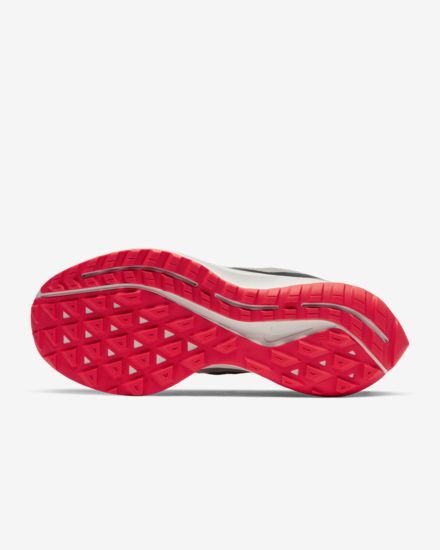
But on smooth and / or wet rocks, these shoes don’t provide confidence-inspiring grip. On a run in the San Gabriel Mountains in California, I fell very hard after stepping on a smooth rock in these shoes. Those looking for a legit, mountain-running shoe for all sorts of technical terrain have much better options. But, my falling aside, if you normally run on dry, less rocky trails, the Pegasus 36 Trail’s traction should be well suited for the terrain.
On The Trail
Overall, I have been impressed with how the Pegasus 36 Trail has performed in a variety of scenarios. My first run in the shoe was on a flat, snow-packed trail. I had great traction the entire duration of the run and never experienced any slipping (a bit of a surprise, given my later issues with it on rocks). Out of the box, the shoe felt energetic and light. My second run in this shoe was the Moab Half Marathon. The rule is to never try anything new on race day, but I figured it was a great opportunity to see how the shoe performed while running fast on sandy singletrack and dirt roads. After this race, I saw why the Pegasus 36 Trail is a great race shoe: I felt fast the whole time — never like my shoes were slowing me down. I ended up running a new PR on that course. I took my shoes off and had no signs of rubbing or blisters, even though there was a notable amount of sand in my shoes.
During training, this shoe quickly became my go-to choice. On the days in Gunnison where I had to run on roads before getting to the trails, I didn’t feel like this shoe slowed me down or was too grabby on the pavement. I enjoyed the shoe both on more technical, rocky terrain as well as smoother dirt paths. As mentioned above, I did slip and fall once due to the shoes not having sufficient traction on a smooth rock in the San Gabriel Mountains. This was the only major incident where I did not have sufficient traction, but for reference, the La Sportiva Kaptiva and Bushido II (review coming soon) and Salomon Sense Ride all offered better grip on smooth and wet rocks. With that being said, I still think the Pegasus 36 Trail works for slightly more technical trails, including Mt. Sanitas in Boulder, Colorado, but I was more thoughtful and cautious about foot placement in this shoe.
My biggest question for these shoes was if they could live up to the hype of their ultra-running capabilities. I decided to put these shoes to the test by running a race in Moab, the Deadhorse 50 mile, in the shoes. Again, I broke the “rules” of racing by taking these almost 2.5-times further than I had ever run in them. I will say I was not running this race at the pace I would normally run, as I was helping a friend to run her first 50-mile race. The course took us across sandy single track and slick rock. I experienced no issues with traction and my feet stayed comfortable and blister-free for the entirety of the race. I did experience some pain in the middle of the pad of my foot, as mentioned in the Fit section. This pain never became unbearable and after taking the shoes off at the end of the event and slipping into some sandals, the pain went away. But the Pegasus 36 Trail’s precise fit, efficient & lightweight ride, and decent traction were all welcome traits for race day. Overall, I was very impressed with the Pegasus 36 Trail for ultra distances, especially where speed is a priority, rather than plush cushioning or excellent grip on rocks. I plan to incorporate this shoe into my lineup for race shoes, regardless of if I will be running fast or slow.
Durability
In my experience, most running shoes can be worn for somewhere between 300-400 miles before being replaced. I tend to wear shoes to, or past the higher end of this range. With that rule in mind, these shoes are about halfway through their life (currently at around 200 miles in them). They are holding up very well and show very little signs of wear. The uppers have no signs of tearing, ripping, or wear near my big toe, which is where I normally first see signs of wear.
The outsole is showing slight signs of wearing, but only to the extent of what is to be expected after running a couple hundred miles in them, including a good portion on slickrock. The lugs are still close to the same size as when I first pulled the shoe out of the box.
I have had good experiences in the past with Nike products lasting me a very long time; this shoe is proving to hold true to this. My first pair of trail-running shoes happened to be Nike’s Wildhorse, which lasted me well over 1,000 miles. I do not plan to put nearly that many miles on these Pegasus 36 Trail, but if they can last me around 500, I will be impressed (especially given how light they are). I’ll report back after I’ve put more miles in these shoes to provide more info on long-term durability.
Who’s It For?
If you are in the market for a shoe that can function as a lightweight, moderately cushioned, everyday trail-running trainer as well as a racing shoe, the Pegasus 36 Trail is a great option. It allows you to travel between roads, singletrack, and dirt roads with an efficient and fast feel, making the Pegasus well suited for a wide variety of needs. Whether you want to run a shorter loop from your house or a 50+ mile race, the Pegasus 36 Trail could fit your needs.
The Pegasus 36 Trail is not a great choice for those who prefer a very cushioned shoe with a very plush feel, nor those who prefer a low-drop shoe, nor those who will be using their shoes on a lot of very technical terrain (particularly smooth and / or wet rocks and roots).
If you have a wide foot, I highly encourage trying on the shoe before purchasing. And even if you have a narrow foot, I would recommend the same. As explained earlier, the Pegasus 36 Trail has a fairly narrow forefoot, even for those of us with narrow feet like myself. I like the snug fit, but the size I had was just a bit too tight and caused some pain.
Bottom Line
The Nike Air Zoom Pegasus 36 Trail is a strong option in the category of lightweight, moderately cushioned trail shoes. From running fast for shorter efforts or a long day on the trail, the Pegasus 36 Trail works quite well, provided its lower-volume fit, higher drop, and firm cushioning align with your preferences.
This shoe fits a bit narrower through the midfoot than many other options, causing some squeezing for my already narrow foot. That said, I experienced no blisters, rubbing, or hot spots in it during runs of varying lengths. But if you have a high-volume foot, this is probably not the right shoe for you. Also, if you prefer a shoe with a larger toe box, this shoe does not provide that. And then if you tend to run rugged, technical, and / or wet trails with slick rocks, the Pegasus 36 Trail may not provide the traction you are searching for.
But for most trails aside from extreme mountain routes or slick, slippery terrain, this shoe provides good traction and a very fast, efficient ride. Initially, I gravitated toward these shoes for faster running, including races and workouts on the trail. But the more I wore them, I felt the amount of cushion, paired with the 10 mm drop, also made them a strong option for slower, longer days of training.

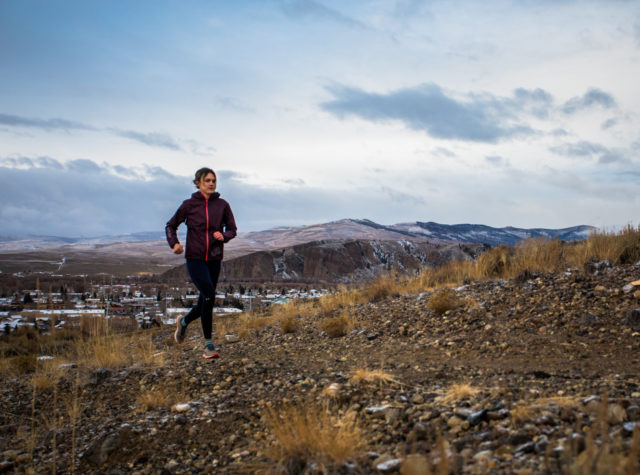
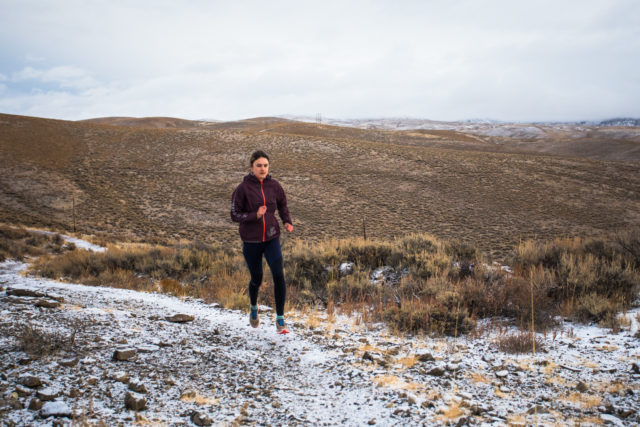
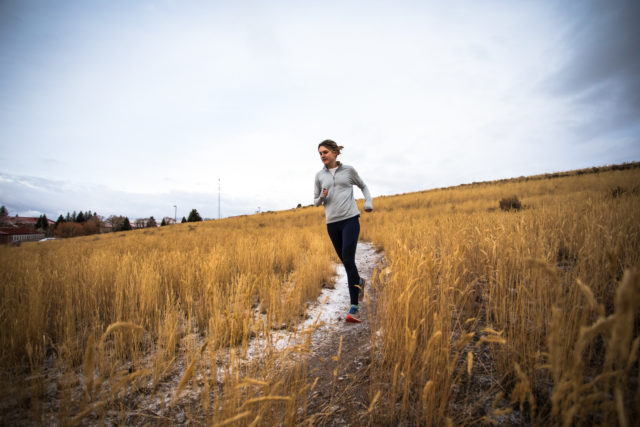
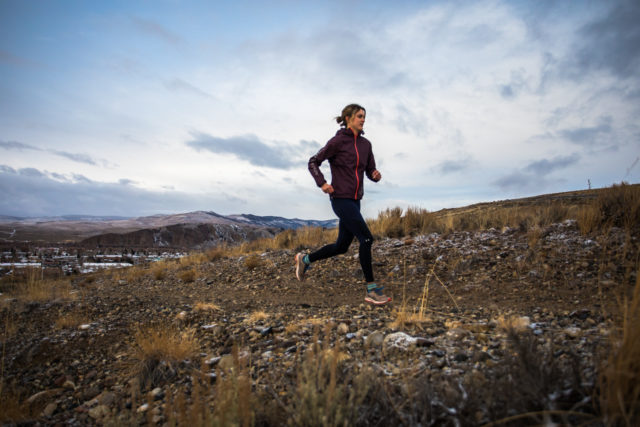
I absolutely love my pegasus 36 trail shoes, so much so that I bought a second pair. I certainly wouldn’t call them narrow – They are snug through the heal and mid foot by very spacious in the toes box – get for my wide feet. Best door to trail shoe on the market.